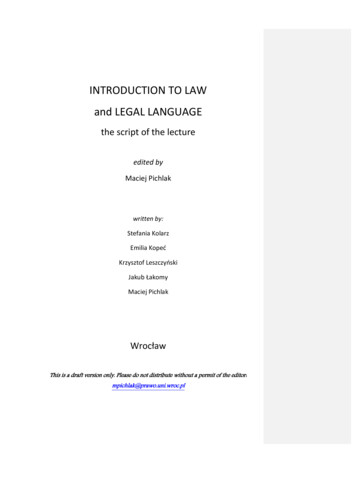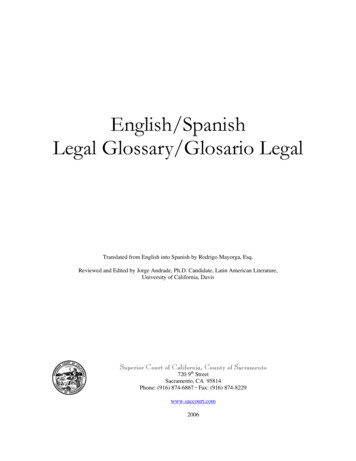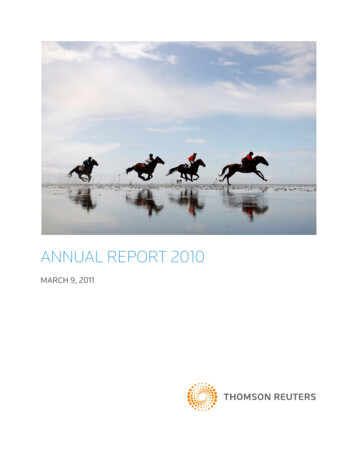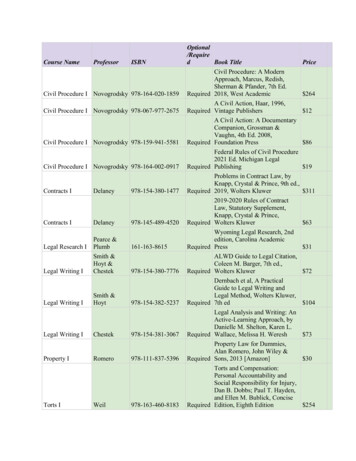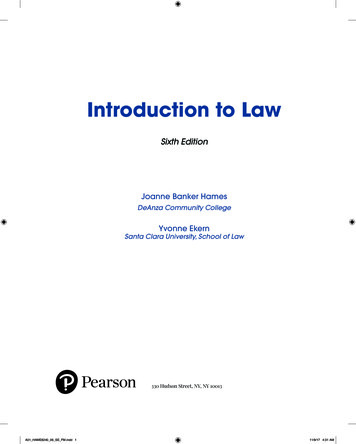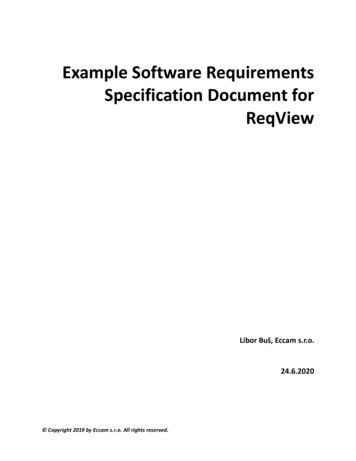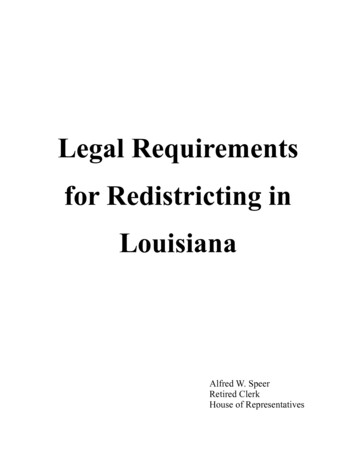
Transcription
Legal Requirementsfor Redistricting inLouisianaAlfred W. SpeerRetired ClerkHouse of Representatives
Table of ContentsI. Introduction1II. Why Redraw District Boundary Lines1A. Reapportionment of Congressional SeatsB. Louisiana Legislative Districts and Louisiana ConstitutionC. Population Shifts within Louisiana111III. Who Will Draw Election Districts2A. Legislative districtsB. Congress, P.S.C., B.E.S.E. Supreme Court, and other courts’ election districtsC. When will the election districts be redrawn?1 Legislative districts2 B.E.S.E.3 Congress, P.S.C., and all judicial election districts233344IV. Population of the State of Louisiana4A. Use Official Census Bureau Population Counts1. What is the census?2. Who is Counted?a) How is the census count reported?b). Exclusion of Undocumented AliensB. May Louisiana utilize an alternative population count?455566V. Measuring Population Equality6A. Equal Population - 1 person, 1 Vote and the 14th Amendment:B. Congressional Plans – as nearly equal as practicable1. “As Nearly Equal in Population as Practicable”2. Unless Necessary to Achieve “Some Legitimate State Objective”C. Legislative Plans1. An Overall Range of Less than Ten Percent2. Unless Necessary to Achieve Some “Rational State Policy”D. Traditional districting principlesE. Safe Harbor78891010121313VI. Don’t Discriminate Against Racial or Language Minorities13A. Section 5 of the Voting Rights Act1. Redistricting plans in Louisiana no longer need preclearance1414
B. Section 2 of the Voting Rights Act1. A National Standard2. No Discriminatory Effect3. The Three Gingles Preconditions4. The Totality of the Circumstances5. Draw Districts the Minority Has a Fair Chance to WinC. Racial Gerrymandering1. A Jurisdiction May Consider Race in Drawing Districts2. Avoid Drawing a Racial Gerrymandera) Beware of Bizarre Shapesb) Draw Districts that are Reasonably Compactc) Beware of Making Race Your Dominant Motived) Beware of Using Other Demographics as a Proxy for Racee) Follow Traditional Districting Principles3. Strict Scrutiny is Almost Always Fatala) A Compelling State Interestb) Narrowly Tailored to Achieve that Interest1) Remedying Past Discrimination2) Avoiding a Violation of Section 215151516171820202121222324242627272828VII. Partisan District Drawing - Gerrymander or No29A. In the Federal CourtsB. On State Constitutional Grounds2929
I. Introduction1This paper will familiarize attendees with the federal and state law and major federalcases that will govern the manner in which the legislature approaches the drawing of electiondistricts in Louisiana following the 2020 census.II. Why Redraw District Boundary LinesA. Reapportionment of Congressional SeatsPopulation shifts that cause changes in the allocation of congressional seats, state to state,are the first reason why Louisiana may have to redraw congressional election district boundarylines. Federal law enacted in 19672 requires congressional districts in the various states be drawnas single member districts. Based upon the 2020 Census population count, Louisiana’s delegationof Members in Congress remains static at 6 after the reapportionment of Congressional seats.B. Louisiana Legislative Districts and Louisiana ConstitutionLA const. art. III, § 6(A) provides: “By the end of the year following the year in whichthe population of this state is reported to the president of the United States for each decennialfederal census, the legislature shall reapportion [sic] the representation in each house as equallyas practicable on the basis of population shown by the census.”This constitutional mandate on the legislature requires the redrawing of all 105representative district boundary lines and the 39 senatorial district boundary lines in 2022.3C. Population Shifts within LouisianaThe third reason to redraw election district boundary lines is that population shifts occurwithin the state’s borders.Even with the number of Congressional, Legislative, Supreme Court, P.S.C., B.E.S.E.,and other election districts not changing in 2022, Louisiana’s population changes over the pastdecade have not been uniform, parish to parish, and because of these disparate populationThe original of this paper was a collaboration among Alfred Speer, Glenn Koepp & Mark Mahaffey; eachcontributing substantial effort to its completion. Some of the research and case citations for parts of this paper weredeveloped by Peter Wattson, former Senate Counsel, MN and the Redistricting and Election Committee members ofthe National Conference of State Legislatures over the past 30 years. A more thorough presentation of many of theissues presented herein may be found in “Redistricting Law – 2020”, National Conference of State Legislatures,Denver, CO, 2019.122 U.S.C. § 2c.3LA const. art. III, §3 caps the number of representatives at 105 and senators at 39.1
changes election district populations shift out of balance.4All parishes have seen changes in legislative district boundaries within their borders ineach of the redistricting rounds since 1970. By way of example, in 1971 Winn Parish was one of3 parishes making up the geography of House District 22. In 1981, Winn Parish was splitbetween districts 13 and 20. In 1991, Winn Parish was split between districts 13 and 23. In 2001,Winn Parish was split among districts 13, 22, & 23. In 2010, Winn parish was split betweendistricts 13 and 22. Winn Parish’s population changes over the past five decades were: 1970 16,369; 1980 17,253; 1990 16,269; 2000 16,894; 2010 15,313; and 2020 13,755. Onecan readily see that population shifts/changes in Winn Parish did not drive the decade by decaderealignment of its geography among House districts. The realignment of Senate districtboundaries have been driven by these same pressures.Since Winn Parish’s population changes did not mandate the geographic realignment,what did? One may think that parishes that have constant population counts have nothing toworry about, since their populations change little from decade to decade. But if the adjacentlegislative districts to the ones into which Winn Parish’s geography is assigned must grow in areadue to population losses or shrink due to population gains, where will those districts pick up, orshed, their new population - the districts immediately adjacent to them, which will then need toreplace that lost population or shed that excess population by taking from or giving to theiradjacent districts. Thus is created a ripple effect that is contained only by the borders ofLouisiana, not by those of individual parishes.Louisiana’s 2010 congressional districts had an overall deviation of 0.03% or 162persons. In 2010, the ideal congressional district population was 755,562; in 2020, the idealpopulation is 776,292. Louisiana’s six districts, as currently configured, range from an overpopulation of 5.18% [6th] to an under-population of -6.18% [4th].5III. Who Will Draw Election DistrictsA. Legislative districtsLA cons. art. III, §6 mandates the legislature redraw the election districts for eachlegislative (House & Senate) district. Current districts are described in R.S. 24:35.2 for the4See, page 7, infra for a discussion of ideal election district populations.5See, https://redist.legis.la.gov/2020 Files/MtgFiles/PowerPoint.pdf, slide 56; last visited Nov. 9, 2021.2
House of Representatives and R.S. 24:35 for the Senate. These statutes will be repealed andreplaced by the 2022 enacted district boundaries, as opposed to the normal amending andreenacting of law. This alternation of the normal statutory amendment process is utilized toprovide a clear history of the precinct assignments to each decade’s successive election districts.B. Congress, P.S.C., B.E.S.E. Supreme Court, and other courts’ election districts:The election districts for the offices of Members in Congress, P.S.C., B.E.S.E., theSupreme Court, and judicial election districts are provided for by law. Changes to these districtsmust be made by Acts of the Legislature.CongressP.S.C.B.E.S.E.Supreme CourtCourts of AppealDistrict CourtsJustices of the Peace- R.S. 18:1276.1- R.S. 45:1161.5- R.S. 17:2.1- R.S. 13:101- R.S. 13:312- R.S. 13:477- R.S. 13:2601 et seq.C. When will the election districts be redrawn?1. Legislative districtsEven though the Louisiana constitution allows the Legislature the entire year of 2022 toredraw their election districts, other legal mandates impose an earlier deadline on this linedrawing exercise. Equal protection of the laws6 requires the first election after the census beconducted using election districts of nearly equal population.7 Further, the Voting Rights Act [52USC §10301 et seq.] [hereinafter “VRA”] mandates that election districts utilized by each statenot deny or abridge the right of any citizen to vote on account of race or color. Failure to redrawelection districts prior to the 2022 congressional election cycle could subject Louisiana to havinga federal court substitute its judgment for that of the legislature as to what election districtboundaries would meet the federal and state constitutional mandates.Therefore, the legal deadline for redrawing legislative district boundaries is December31, 2022. The deadline for re-drawing congressional district lines is no later than July 20, 2022 the opening date for qualifying. However, the functional deadline for the Legislature is much6U.S. const., amendment XIV and LA const. art. I, §3.7See, discussion page 7, infra.3
earlier; taking in account the need for Gubernatorial approval of the Act re-drawing the electionboundaries.2. B.E.S.E.The same time table and deadline applies to the drawing of these election districts as forlegislative districts because the elections of the members of the B.E.S.E. board occur in 2023.3. Congress, P.S.C., and all judicial election districtsThe elections for these offices occur on the congressional election schedule [fall of evennumbered years]. Because the legal mandates discussed above which are applicable to theseelections arise in 2022, the functional deadlines for line drawing and any possibility of a courtintervention, will fall early in 2022.8IV. Population of the State of LouisianaA. Use Official Census Bureau Population CountsThe first legal requirement for any redistricting plan is to draw districts of substantiallyequal population.9 But how does the line-drawer know the state’s population and what is thetarget population for substantially equal district populations? The straight-forward answer is: theofficial census bureau population counts from the 2020 census.10LA const. art. III, §6 mandates the use of the federal census population counts to drawlegislative districts: “. . . on the basis of population shown by the census.” This mandate iseffective ONLY for legislative districts; however, the Legislature has traditionally utilized thecensus population figures to draw election districts for Members in Congress, P.S.C., B.E.S.E.,the Supreme Court, and election districts for the courts of appeal, district courts, and justices ofthe peace.The 2022 regular legislative session convenes March 14, 2022, adjourning no later than June 6, 2022. TheLegislature traditionally has debated redistricting bills in an extraordinary session; expectations are that such asession will be held prior to the regular session.89See, discussion page 7, infra.For a discussion of alternative population counts, See, ting/How to draw redistricting plans PeterWattson.pdf, pas 8-9; last visited Nov. 9, 2021.104
1. What is the census?U.S. Public Law 94-171 directs the Census Bureau to send to the states the populationdata for those persons residing in the state at the time of the census [October 15, 2020] brokendown into racial groups, language groups, and age groups and reported by geographic units.2. Who is Counted?a) How is the census count reported?After the completion of the 2020 census, the president transmitted to Congress astatement of the apportionment of the 435 representative seats among the states. The number ofrepresentatives allocated to each state is based on the census results and determined by the“method of equal proportions.”11 Each state is guaranteed at least one representative, and theremaining 385 seats are apportioned among the states by assigning priority values to each seat.Title 13, U.S.C., as amended by Public Law 94-171, requires the Secretary of Commerce toreport census results no later than April 1 the year following the census to the Governor andLegislative leaders. This census cycle was interrupted by the global pandemic resulting in thereport to the states occurring August 12, 2021. This report contains the population anddemographic data for various geographical areas within the state, including the smallest areas,the “census blocks.” The initial report provides the population basis for Louisiana’s decennialredistricting efforts.The census figures critical to redistricting are: total population counts for each unit ofgeography, 252 separate racial/language group categories, and voting age population breakdownsfor each population category. These 252 separate racial/language categories are distilled down tothose that are required for adopting defensible election districts.12From the Secretary of State, the Legislature also collects the voter registration data mostconcurrent with the census date (July, 2021) and appends that data as demographic data in theredistricting data set.For an explanation of this apportionment formula visit: ssional-apportionment/about/computing.html; last visited October 22, 2021.11See, “Allocation of 2020 Census Population for Database and Reporting”https://redist.legis.la.gov/2020 opulation%20for%20Database%20and%20Reporting.pdf; last visitedNov. 9, 2021. See also, the paper “How to Draw Redistricting Plans That Will Stand Up in Court”, Wattson, Peter S.;N.C.S.L. at ting/How to draw redistricting plans PeterWattson.pdf; last visited Nov. 9, 2021.125
The Legislature uploads the census population figures, by category, and the voterregistration figures into their internal database/redistricting GIS software and conducts rigorousdata verification procedures to insure the data matches the geography used to draw districts.b). Exclusion of Undocumented AliensThe census is not limited to citizens. It is not even limited to permanent residents. TheU.S. Constitution mandates the census count “persons,” Art. I, §2 (as amended by the 14thAmendment). Therefore, documented aliens, undocumented aliens (who respond to the bureau’scanvas), military personnel stationed within the state, and college students living in the state arecounted as part of Louisiana’s population. It goes without saying that to have been counted eachof these persons first must have responded to the census bureau’s mailings or personal visit totheir place of residence; or have visited census.gov to have answered the census on-line.Pennsylvania and other states have sought, without success, to require the Bureau toexclude undocumented aliens from the population counts used to apportion the members ofCongress among the states.13B. May Louisiana utilize an alternative population count?LA const. art. III, §6 mandates the use of the federal census population counts to drawlegislative districts: “. . . on the basis of population shown by the census.” Furthermore, R.S.18:1906 mandates that the census population figures shall be those as tabulated under theprovisions of Public Law 94-171.14V. Measuring Population EqualityHow will the Legislature, and possibly a court, measure the degree of population equalityin a redistricting plan?The process starts with establishing an “ideal district population” which is arrived at bydividing the total population of a jurisdiction by the number of districts to be drawn for thatjurisdiction.Ridge v. Verity, 715 F. Supp. 1308 (W.D. Pa. 1989); Federation for American Immigration Reform (FAIR) v.Klutznick, 486 F. Supp. 564 (D.D.C. 1980); appeal dismissed, 447 U.S. 916 (1980).13The federal statute that requires the Census Bureau to provide, by April 1 of each year following a decennialcensus, the population and race data necessary for redistricting. See also, discussion of this tabulation at IV.A.2(a),page 5, supra.146
If a jurisdiction had a population of 4 million and was entitled to elect 10 office holders,the average or “ideal” district population would be 400,000. If the line drawers create adistricting plan that has five districts with a population of 380,000 and five districts with apopulation of 420,000, the “deviations” of the districts would be -20,000 and 20,000, or minus5 percent and plus 5 percent. The “average deviation” from the ideal would be 20,000 or 5percent; and the “overall range” would be 40,000, or 10 percent.Most courts have used what statisticians call the “overall range” to measure thepopulation equality of a redistricting plan, though they have usually referred to it by other names,such as “maximum deviation,” “total deviation,” or “overall deviation.”A. Equal Population - 1 person, 1 Vote and the 14th Amendment:The 14th amendment’s equal protection clause,15 as interpreted by the U. S. SupremeCourt, requires that each voter’s choice in exercising their franchise is weighted the same as eachother voter’s choice. This interpretation of the equal protection clause has acquired a short-handname: “1 person, 1 vote.” This phrase represents the legal mandate that in drawing electiondistricts the population of each election district, relative to the others, AND the populationvariance of ALL the districts must be so numerically exact as to not violate the principle ofcounting each person’s vote equally with all others votes. It is a truism of state election districtline drawing that absolute numbers are less important than relative numbers. Getting thenumbers right is important, that is drawing a district that closely approximates the “ideal”population, but once all districts are drawn, the concern must shift to how the districts relate toeach other; what is the “overall range” of the districts’ deviation from the “ideal”.Even if all areas of a state are growing, what is important for each region, or each district,is whether it has grown faster or slower than the state’s overall population growth. Districts thathave gained population at a slower pace than the state as a whole will have to gain geography,and the population living on that geography, to keep its population in pace with the growing“ideal” district number. Districts that have gained population at a faster pace than the state as awhole will have to lose geography, and its resident population, to shrink its population to remainin pace with the ideal district number.16 These losses and gains of population by moving15No state shall “. . . deny to any person within its jurisdiction the equal protection of the laws.”16See, example of Winn parish page 2, supra.7
geography are necessary to keep the “overall range” of all districts’ deviation from the “ideal”district number within constitutional limits.How equal in population must election districts be? The federal courts use two differentstandards for judging the equality of population in redistricting plans - one for congressionalplans and a different one for legislative plans.B. Congressional Plans – as nearly equal as practicable1. “As Nearly Equal in Population as Practicable”The population deviation standard for congressional plans is based on Article I, §2, of theU.S. Constitution, which says: “Representatives . . . shall be apportioned among the severalStates . . . according to their respective numbers . . . .”The population deviation standard for congressional plans is strict equality as articulatedin a 1964 case, wherein the Supreme Court stated that the population variance of congressionaldistricts must be “as nearly equal in population as practicable.”17 This is a critically importantchoice of words since the Court did not mandate that the populations be as nearly equal aspractical. “Practicable” is defined as “capable of being put into practice or of being done oraccomplished : FEASIBLE.”18 Note that something “practical” is not only capable of beingdone, but also sensible and worthwhile. The difference between the two terms is critical and maybe illustrated thus: it might be practicable to cast votes over the internet, but it would not bepractical. The distinction to be drawn is that the legal requirement is not what is convenient,sensible, or straight-forward, but the standard mandates states minimize the congressional districtpopulation differences to the greatest degree as is capable of being achieved.In 1983 the Supreme Court struck down a congressional redistricting plan drawn by theNew Jersey legislature that had an “overall range” of .6984%, or 3,674 people.19 The plaintiffsshowed that at least one other plan before the legislature had an overall range less than the planenacted by the legislature, thus carrying their burden of proving that the population differencescould have been reduced or eliminated by a good-faith effort to draw districts of equal17Wesberry v. Sanders, 376 U.S. 1 (1964).Merriam-Webster on-line dictionary; able. Last visitedOctober 22, 2021.1819Karcher v. Daggett, 462 U.S. 725 (1983).8
population. That is to say, the population differences among the districts were not as nearly equalas practicable. This showing by the plaintiffs shifted the burden of proof to the state to show thereasons for the deviations.20With the advances in the census population reports and in computer technology used todraw districting plans which have occurred since the 1980 census, the degree to whichpopulation equality may be realized, that is “practicable,” approaches closer to zero with everydecade.21 If a state finds it difficult to draw congressional districts that are mathematically equalin population the line drawers in that state should not assume that third parties will find the samedifficulties. When line drawers surrender to difficulties and fail to reach the lowest point ofdeviation as “practicable,” their surrender places the congressional plan at risk of challenge andreplacement by another plan with a lower overall range drawn either by outside interests or bythe courts.2. Unless Necessary to Achieve “Some Legitimate State Objective”Even if a challenger is able to draw a congressional plan with a lower overall range, theadopted plan may still be upheld by a reviewing court.To overcome a challenge based upon 1 person, 1 vote, the state must carry the burden ofproof; showing that each “significant” deviation from the ideal population was necessary toachieve “some legitimate state objective.” As Justice Brennan wrote:“Any number of consistently applied legislative policies might justify somevariance, including, for instance, making districts compact, respecting municipalboundaries, preserving the cores of prior districts, and avoiding contests betweenincumbent Representatives . . . . The State must, however, show with somespecificity that a particular objective required the specific deviations in its plan,rather than simply relying on general assertions . . . . By necessity, whetherdeviations are justified requires case-by-case attention to these factors.”[emphasis added]22In order to rely on these “legitimate state objectives” to justify population inequality in acongressional plan the RECORD of each committee and each house MUST articulate thoseobjectives in advance, follow them consistently, and be prepared to show the impossibility of20See, the discussion of Legitimate State Objective at V.B.2., infra.See, N. C. S. L., “Redistricting 2010 Deviation Table”. cslredistricting-deviation-table.aspx. Last visited October 22, 2021 and note 16, supra.2122Karcher v. Daggett, supra at 740-41.9
achieving those objectives, district by district, with district boundaries that had a smallerdeviation from the ideal. In the 1990s, Arkansas, Maryland, and West Virginia all were able tomeet this heavy burden of proof when their congressional plans were challenged in court.Near the end of the 1990s, the Supreme Court upheld a court-drawn congressional plan inGeorgia with an overall range of 0.35 percent (about 2,000 people).23 The burden was carried byshowing that the plan represented the lowest range of all the plans that met constitutionalrequirements, Georgia was able to show it had a consistent historical practice of not splittingcounties outside the Atlanta area, and likely shifts in population since 1990 had made any furthereffort to achieve population equality illusory.In the 2000s, Georgia and Kansas met their Karcher burden, while 22 states drewcongressional plans with a deviation of more than one person that were not challenged. In the2010s, West Virginia again withstood an equal-population challenge to its congressional plan,this time because it used whole counties, avoided contests between incumbents, and shiftedfewer people from one district to another than other plans with lower deviations. Twelve statesdrew congressional plans with an overall range of more than one person that were notchallenged.24A line drawer should be mindful that IF the state has ignored one of these articulatedprinciples to accomplish some political goal, to draw some convenient district, the task ofconvincing a reviewing court that, in drawing the contested plan, the line drawer was compelledby these principles will be very difficult. Once these principles have been ignored, the state facesan impossibly steep burden to convincingly argue the necessity of adhering to the principles inthe current, contested plan. Consistent application of the districting principles within an adoptedplan also is scrutinized by the courts when assessing whether a state meets its Karcher burden ofproof.C. Legislative Plans1. An Overall Range of Less than Ten PercentThe U. S. Supreme Court has adopted a less exacting overall deviation standard for23Abrams v. Johnson, 521 U.S. 74 (1997)See, 2010 Redistricting Deviation Table, note 22, supra and N. C. S. L., “Action on Redistricting Plans:2011-20”, ting/Redistricting actionplan 2010thru2020.pdf. Lastvisited October 22, 2021.2410
legislative districting plans than the one applied to congressional districting plans. This lessstringent standard is not grounded in the “apportionment clause” of the U.S. constitution25, whichgoverns congressional plans. Rather, state legislative districting deviation is governed by theEqual Protection Clause of the 14th Amendment.26As Chief Justice Warren observed: “mathematical nicety is not a constitutional requisite”when drawing legislative plans.27 All that is necessary is that they achieve “substantial equalityof population among the various districts.”28“Substantial equality of population” has come to mean that a legislative plan with an“overall range” of less than ten percent may survive an equal protection attack, unless there isproof of intentional discrimination within that range.29 Numerous district courts have relied uponthe Supreme Court’s language to find that legislative districting plans with a maximumpopulation deviation under 10% fall within the category of minor deviations that are insufficientto establish a prima facie violation of the equal protection clause.This “ten-percent rule” was first articulated in a dissenting opinion written by JusticeBrennan in the cases of Gaffney and Regester. In later cases, the Court’s majority has endorsedand followed the rule.30However, c ompliance with an arbitrary “ten percent rule” does not end a court’s inquiryas to whether a districting plan violates the 1 person, 1 vote principle.In a 2004 New York district court opinion, the court stated:“[w]e think that Brown, Mahan, Gaffney, and Abate . . . lend support to theproposition that the “ten percent rule” is not meant to protect a state that is25See, B.1., supra pg. 8.“Amendment XIV: Section 1. . . nor shall any state deprive any person of life, liberty, or property, without due process of law; nor deny to anyperson within its jurisdiction the equal protection of the laws.” xiv. Last visited November 10, 2021.2627Reynolds v. Sims, 377 U.S. 533 (1964).28Id. at 579.29Reynolds v. Sims, supra, Gaffney v. Cummings, 412 U.S. 735 (1973), and White v. Regester, 412 U.S. 755 (1973).See, e.g., Chapman v. Meier, 420 U.S. 1 (1975); Connor v. Finch, 431 U.S. 407 (1977); Brown v. Thomson, 462U.S. 835 (1983); and Voinovich v. Quilter, 507 U.S. 146 (1993).3011
systematically disadvantaging groups of voters with no permissible rationaljustification for the disproportion.”31Thus, plans within the “ten percent rule” are not immune from attack. The attacking plaintiffsmust present compelling evidence that the plan ignores the legitimate reasons for populationdisparities and creates the deviations solely to benefit certain persons at the expense of others tosupport an equal protection clause action.Thus, an overall range of less than ten percent is not a “safe harbor.” In a 2004 Georgiadistrict court opinion,32 the court found that:1) Georgia had systematically under-populated districts in rural south Georgia andinner-city Atlanta and overpopulated districts in the suburban areas north, east,and west of Atlanta in order to favor Democratic candidates and disfavorRepublican candidates;2) the plan systematically paired Republican incumbents while reducing thenumber of Democratic incumbents who were paired; and3) the plan ignored the traditional districting principles used in previous decades,such as keepin
the National Conference of State Legislatures over the past 30 years. A more thorough presentation of many of the issues presented herein may be found in “Redistricting Law – 2020”, National Conference of State Legislatures, Denver, CO, 2019. 2 2 U.S.C. § 2c. 3 LA const. art.

